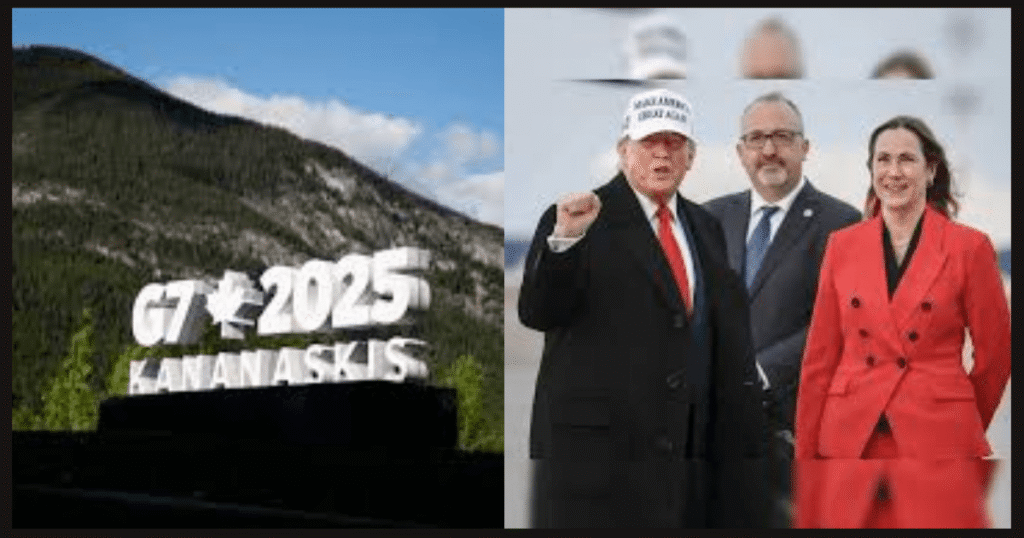The 51st G7 Summit, held from June 16 to 17, 2025, in the stunning Rocky Mountains of Kananaskis, Alberta, Canada, was meant to be a big deal for global leaders to discuss the world’s toughest problems. But it grabbed headlines for a different reason: U.S. President Donald Trump left the summit early, leaving other leaders to carry on talks about peace, trade, and global challenges without him. For Indians watching from afar, this event was especially interesting because Prime Minister Narendra Modi was there, representing India’s growing voice on the world stage.
What is the G7 Summit?
The G7, or Group of Seven, is a club of seven of the world’s richest and most powerful countries: the United States, Canada, the United Kingdom, France, Germany, Italy, and Japan. Every year, their leaders meet to talk about big issues like the economy, war, climate change, and global security. This time, Canada hosted the summit in a beautiful mountain resort called Kananaskis. Besides the G7 countries, leaders from other nations like India, Brazil, South Africa, Mexico, Ukraine, Australia, and South Korea were invited to join parts of the talks, making it a bigger global gathering.
Why Was the Summit a Big Deal?
The 2025 G7 Summit came at a tense time. The world was dealing with major problems:
- Middle East Conflict: Israel and Iran were attacking each other, raising fears of a bigger war. Leaders wanted to calm things down and stop Iran from building nuclear weapons.
- Ukraine War: Russia’s war in Ukraine was still going strong, and leaders were discussing how to support Ukraine.
- Trade Fights: Trump’s new tariffs (taxes on imported goods) on countries like Canada, Japan, and the European Union were causing trouble for global trade.
- India’s Role: With PM Modi attending, India had a chance to shine and push for stronger ties with these powerful nations.
But the summit wasn’t just about solving problems—it was also about leaders getting along (or not). Trump’s actions made sure all eyes were on him.
Trump’s Early Exit: What Happened?
On June 16, the first day of the summit, Trump arrived in Canada and met with leaders like Canadian Prime Minister Mark Carney and British Prime Minister Keir Starmer. He even signed a trade deal with the UK to lower some tariffs. But late that night, the White House announced he was leaving early to return to Washington, D.C. Why? Trump said it was because of the “big stuff” happening in the Middle East, especially the Israel-Iran conflict. His team claimed he needed to focus on stopping Iran from getting nuclear weapons.
This wasn’t the first time Trump left a G7 summit early. In 2018, he walked out of a summit in Quebec, Canada, after a fight with then-Prime Minister Justin Trudeau. This time, his exit left leaders like Ukraine’s President Volodymyr Zelenskyy and Mexico’s President Claudia Sheinbaum without a chance to meet him face-to-face, which they had hoped to do. Some people on social media, like posts on X, called Trump’s move a sign he didn’t want to deal with leaders who disagree with him. Others said he was just focusing on urgent issues back home. Either way, his departure made the summit feel a bit like a party missing its main guest.
The Middle East Mess: Why It Mattered
The Israel-Iran conflict was a hot topic at the summit. Israel had launched airstrikes on Iran, targeting its military and nuclear sites, while Iran hit back with missiles and drones. This fighting worried world leaders because it could disrupt oil supplies and push the world closer to a bigger war. The G7 leaders, including Trump before he left, signed a statement saying:
- Israel has the right to defend itself.
- Iran must not get nuclear weapons.
- Both sides should calm down and talk instead of fight.
Trump caused a stir by posting on his social media platform, Truth Social, that everyone in Tehran, Iran’s capital, should “evacuate immediately.” He didn’t explain why, which led to rumors about whether the U.S. might join Israel’s attacks. American officials quickly said the U.S. wasn’t involved, but Trump’s words kept people guessing. For India, this matters because any war in the Middle East could spike oil prices, hitting our economy hard since we import a lot of oil.
India’s Moment: PM Modi at the Summit
Prime Minister Narendra Modi arrived in Canada on June 16 to join the summit, marking his first visit to the country since this G7 meeting. India isn’t a G7 member, but it’s often invited because of its growing power and massive economy. Modi’s presence was a chance to show India’s importance in solving global problems. He was expected to meet leaders like Carney and Starmer to strengthen ties, especially on trade and security.
A Canadian lawmaker praised India, saying it’s a “great country” with a “gigantic market” and a “motivated, educated population.” This shows how much the world values India’s role. Modi likely pushed for better trade deals and cooperation on issues like climate change and technology, which are big priorities for India. His visit also came at a time when India-Canada relations have faced ups and downs, so it was a chance to build bridges.
Other Big Talks: Ukraine, Trade, and More
Even without Trump, the summit went on. Leaders focused on:
- Supporting Ukraine: Canadian PM Carney promised “unwavering” support for Ukraine against Russia. Zelenskyy joined the talks on June 17 to ask for more weapons and sanctions on Russia. Trump, however, said it was a “mistake” to kick Russia out of the G8 (as it was called before 2014), which worried some leaders about his support for Ukraine.
- Trade Troubles: Trump’s tariffs on Canada, Japan, and others caused tension. Canada and the U.S. agreed to work on a new trade deal within 30 days, but it’s unclear if they’ll succeed. India, too, is watching these trade fights closely, as they could affect our exports.
- Other Issues: The summit also covered artificial intelligence (AI), critical minerals (like lithium for batteries), and energy security. These are areas where India has a lot to offer, especially in tech and green energy.
Why Does This Matter for India?
For the average Indian, the G7 Summit might seem far away, but it affects us in big ways:
- Oil Prices: If the Israel-Iran conflict worsens, petrol and diesel prices in India could shoot up, making everything from food to transport more expensive.
- Trade and Jobs: Trump’s tariffs and trade fights could hurt Indian exports like medicines, textiles, and tech services. Modi’s talks at the summit could help protect our economy.
- Global Power: India’s presence at the G7 shows we’re a major player in the world. When Modi speaks, the world listens, and that’s good for our pride and influence.
- Peace and Stability: India wants a peaceful world to focus on growth. The G7’s efforts to calm the Middle East and Ukraine matter to us because war anywhere can hurt everyone.
What’s Next?
The G7 Summit ended on June 17, but its impact will last. Trump’s early exit left some leaders frustrated, but they still managed to agree on a statement about the Middle East and support for Ukraine. For India, Modi’s visit was a chance to strengthen ties with Canada and other G7 nations. Back home, we’ll be watching how the Israel-Iran conflict and global trade talks play out. If oil prices rise or trade deals falter, it could hit our wallets. But if Modi’s diplomacy works, India could come out stronger.
The summit showed how unpredictable the world is right now. With leaders like Trump stirring things up and conflicts raging, the G7 is trying to keep things steady. For India, it’s a reminder that we’re not just watching from the sidelines—we’re part of the global conversation, and our voice matters.
Also Read : Sri Lanka vs Bangladesh: New WTC Cycle Starts with a Bang on June 17!

